The last actually required that I also make a loaf of buttery brioche, because it uses one-half recipe of that dough. Yes, these sticky rolls are extra sinful because brioche is its base. The chilled dough is rolled out, filled with even more butter, cinnamon, and sugar, then cut into rolls. The rolls are placed in a baking dish with the honey glaze and pecans, and the whole thing is baked for 30 minutes. The rolls are unmolded immediately after coming out of the oven, the glaze bubbling all around them, and happily devoured by anyone standing nearby.
One of the great things about this recipe is that you don't have to make a ton of rolls at once if you don't want (for instance, if you're only serving one or two people). They don't keep well after they've been baked, so you don't want to make a lot if they're not going to be eaten right away. However, immediately after you've made the dough log (or even after cutting the log into individual buns), you can wrap the dough and store it in the freezer until you're ready to make another batch, and adjust the amount of glaze accordingly.

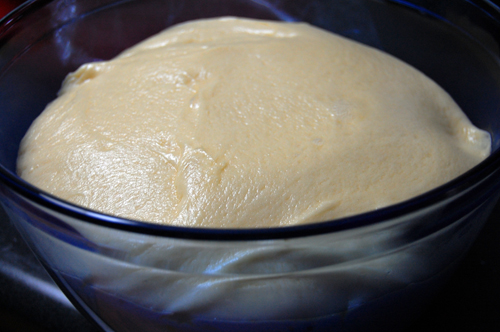
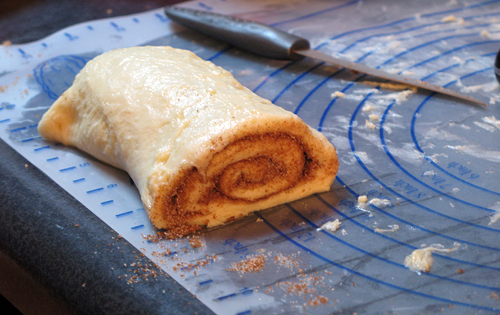

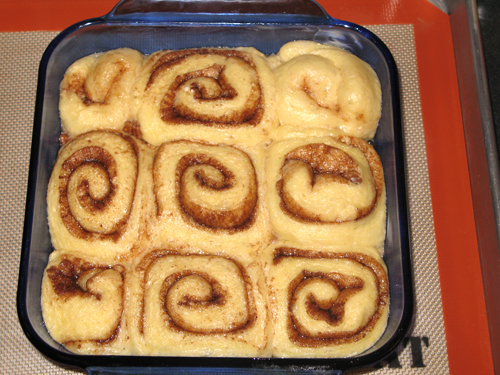
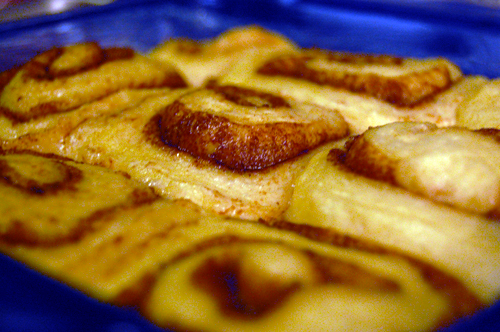

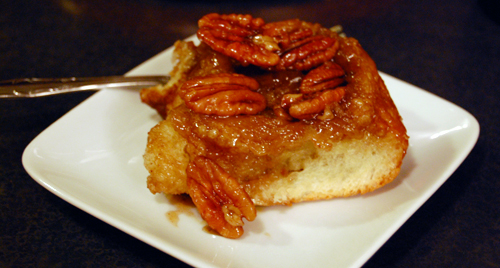
Pecan Honey Sticky Buns from Dorie Greenspan's Baking: From My Home to Yours
Makes 15 buns
Ingredients:
For the glaze:
- 1 cup (packed) light brown sugar
- 8 tbsps unsalted butter, cut into 4 pieces
- 1/4 cup honey
- 1-1/2 cups pecans (whole or pieces)
- 1/4 cup sugar
- 3 tbsps (packed) light brown sugar
- 1 tbsp ground cinnamon
- 3 tbsps unsalted butter, at room temperature
- 1/2 recipe dough for Golden Brioche loaves (below), chilled and ready to shape (make the full recipe and cut the dough in half after refrigerating it overnight)
- Generously butter a 9x13-inch baking pan (a Pyrex pan is perfect for this).
- To make the glaze: In a heavy-bottomed saucepan, bring the brown sugar, butter, and honey to a boil over medium-low heat, stirring frequently to dissolve the sugar. Pour the glaze into the buttered pan, evening it out as best you can by tilting the pan or spreading the glaze with a heatproof spatula. Sprinkle over the pecans.
- To make the filling: Mix the sugars and cinnamon together in a bowl. If necessary, in another bowl, work the butter with a spatula until it is soft, smooth and spreadable.
- To shape the buns: On a flour-dusted work surface, roll the chilled dough into a 16-inch square. Using your fingers or a pastry brush, spread the softened butter over the dough. Sprinkle the dough with the cinnamon sugar, leaving a 1-inch strip bare on the side farthest from you. Starting with the side nearest you, roll the dough into a cylinder, keeping the roll as tight as you can. (At this point, you can wrap the dough airtight and freeze it for up to 2 months . . . . Or, if you want to make just part of the recipe now, you can use as much of the dough as you’d like and freeze the remainder. Reduce the glaze recipe accordingly).
- With a chef’s knife, using a gentle sawing motion, trim just a tiny bit from the ends of the roll if they’re very ragged or not well filled, then cut the log into 1-inch thick buns. (Because you trim the ragged ends of the dough, and you may have lost a little length in the rolling, you will get 15 buns, not 16.) Fit the buns into the pan cut side down, leaving some space between them.
- Lightly cover the pan with a piece of wax paper and set the pan in a warm place until the buns have doubled in volume, about 1 hour and 45 minutes. The buns are properly risen when they are puffy, soft, doubled and, in all likelihood, touching one another.
- Getting ready to bake: When the buns have almost fully risen , center a rack in the oven and preheat the oven to 375 degrees F.
- Remove the sheet of wax paper and put the pan on a baking sheet lined with parchment or a silicone mat. Bake the sticky buns for about 30 minutes, or until they are puffed and gorgeously golden; the glaze will be bubbling away merrily. Pull the pan from the oven.
The sticky buns must be unmolded minutes after they come out of the oven. If you do not have a rimmed platter large enough to hold them, use a baking sheet lined with a silicone mate or buttered foil. Be careful - the glaze is super-hot and super-sticky.
Golden Brioche Dough
Ingredients
- 2 packets active dry yeast
- 1/3 cup just-warm-to-the-touch water
- 1/3 cup just-warm-to-the-touch whole milk
- 3 1/3 cups all-purpose flour
- 2 teaspoons salt
- 3 large eggs, at room temperature
- 1/4 cup sugar
- 3 sticks (12 ounces) unsalted butter, at room temperature but still slightly firm
Glaze for the loaves:
- 1 large egg
- 1 tablespoon water
Method
- Put the yeast, water and milk in the bowl of a stand mixer and, using a wooden spoon, stir until the yeast is dissolved. Add the flour and salt, and fit into the mixer with the dough hook, if you have one. Toss a kitchen towel over the mixer, covering the bowl as completely as you can– this will help keep you, the counter and your kitchen floor from being showered in flour. Turn the mixer on and off a few short pulses, just to dampen the flour (yes, you can peek to see how you’re doing), then remove the towel, increase the mixer speed to medium-low and mix for a minute or two, just until the flour is moistened. At this point, you’ll have a fairly dry, shaggy mess.
- Scrape the sides and bottom of the bowl with a rubber spatula, set the mixer to low and add the eggs, followed by the sugar. Increase the mixer speed to medium and beat for about 3 minutes, until the dough forms a ball. Reduce the speed to low and add the butter in 2-tablespoon-size chunks, beating until each piece is almost incorporated before adding the next. You’ll have a dough that is very soft, almost like batter. Increase the speed to medium-high and continue to beat until the dough pulls away from the sides of the bowl, about 10 minutes.
- Transfer the dough to a clean bowl (or wash out the mixer bowl and use it), cover with plastic wrap and leave at room temperature until nearly doubled in size, 40 to 60 minutes, depending upon the warmth of your room.
- Deflate the dough by lifting it up around the edges and letting it fall with a slap to the bowl. Cover the bowl with the plastic wrap and put it in the refrigerator. Slap the dough down in the bowl every 30 minutes until it stops rising, about 2 hours, then leave the uncovered dough in the refrigerator to chill overnight.
- The next day, butter and flour two 8 1/2-x-4 1/2-inch pans.
- Pull the dough from the fridge and divide it into 2 equal pieces. Cut each piece of the dough into 4 equal pieces and roll each piece into a log about 3 1/2 inches long. Arrange 4 logs crosswise in the bottom of each pan. Put the pans on a baking sheet lined with parchment or a silicone mat, cover the pans lightly with wax paper and leave the loaves at room temperature until the dough almost fills the pans, 1 to 2 hours. (Again, rising time with depend on how warm the room is.)
- Getting Ready To Bake: Center a rack in the oven and preheat the oven to 400 degrees F.
To Make the Glaze: Beat the egg with the water. Using a pastry brush, gently brush the tops of the loaves with the glaze. - Bake the loaves until they are well risen and deeply golden, 30 to 35 minutes. Transfer the pans to racks to cool for 15 minutes, then run a knife around the sides of the pans and turn the loaves out onto the racks. Invert again and cool for at least 1 hour.
